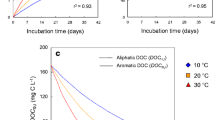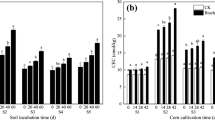Abstract
The aim of this study was to assess how the solubility and the speciation of Cd in soil solution were affected over time by the soil temperature for three metal-contaminated soils. The changes of solution Cd concentration (either total or free ionic) and other physico-chemical parameters (e.g. pH, ionic strength, the concentrations of \({\text{NO}}_3^ - \), \({\text{SO}}_4^{2 - } \), Ca, Mg and dissolved organic carbon) were monitored over a 28-day culture of lettuce (Lactuca sativa L.) in soils incubated at 10°C, 20°C or 30°C. The major result of this study was that Cd2+ concentration greatly varied over time in soil solution. The Cd2+ concentration declined over time in soil solution as did the concentration of cations that may compete for adsorption (Ca2+, Mg2+). The rise in soil temperature primarily impacted on the concentration of Cd2+ via promoting the microbial C-degradation and, thus, the complexation of Cd in soil solution. The integration of the temporal variations in Cd2+ concentration through the calculation of the root exposure to solution Cd (E Cd) provided a fairly close and robust prediction of Cd concentration in lettuce roots. The present work thus provided new insights on the fate of Cd in contaminated soils that may be relevant for predicting the root uptake of Cd.





Similar content being viewed by others
References
Adriano DC (2001) Trace elements in terrestrial environments. Springer, New York
Almas AR, Singh BR (2001) Plant uptake of cadmium-109 and zinc-65 at different temperature and organic matter levels. J Environ Qual 30:869–877
Chanmugathas P, Bollag JM (1987) Microbial mobilization of cadmium in soil under aerobic and anaerobic conditions. J Environ Qual 16:161–167
Clemens S (2001) Molecular mechanisms of plant metal tolerance and homeostasis. Planta 212:475–486
Cornu JY, Denaix L, Schneider A, Pellerin S (2007a) Temporal evolution of redox processes and Cd dynamics in a metal-contaminated soil after rewetting. Chemosphere 70:306–314
Cornu JY, Staunton S, Hinsinger P (2007b) Copper concentration in plants and in the rhizosphere as influenced by the iron status of tomato (Lycopersicon esculentum L.). Plant Soil 292:63–77
Costa G, Morel JL (1994) Efficiency of H+-Atpase activity on cadmium uptake by 4 cultivars of tettuce. J Plant Physiol 17:627–637
FAO (2006) Guidelines for soil profile description.. F.A.O, Rome, Italy
Fotovat A, Naidu R (1998) Changes in composition of soil aqueous phase influence chemistry of indigenous heavy metals in alkaline sodic and acidic soils. Geoderma 84:213–234
Hamon RE, Lorenz SE, Holm PE, Christensen TH, McGrath SP (1995) Changes in trace-metal species and other components of the rhizosphere during growth of radish. Plant Cell Environ 18:749–756
Hart JJ, Welch RM, Norvell WA, Sullivan LA, Kochian LV (1998) Characterization of cadmium binding, uptake, and translocation in intact seedlings of bread and Durum wheat cultivars. Plant Physiol 116:1413–1420
Hinsinger P (2001) Bioavailability of trace elements as related to root-induced chemical changes in the rhizosphere. In: Gobran GR, Wenzel WW, Lombi E (eds) Trace elements in the rhizosphere. CRC, Boca Raton, pp 25–41
Kirk GJD (2004) The biogeochemistry of submerged soils. Wiley, Chichester, England
Lehoczky E, Szabo L, Horvath S, Marth P, Szabados I (1998) Cadmium uptake by lettuce in different soils. Commun Soil Sci Plant Anal 29:1903–1912
Lindsay WL (1979) Chemical equilibria in soils. Wiley, New York
Marschner B, Bredow A (2002) Temperature effects on release and ecologically relevant properties of dissolved organic carbon in sterilised and biologically active soil samples. Soil Biol Biochem 34:459–466
Marschner H (1986) Mineral nutrition of higher plants. Academic, London
McLaughlin MJ, Palmer LT, Tiller KG, Beech TA, Smart MK (1994) Increased soil-salinity causes elevated cadmium concentrations in field-grown potato-tubers. J Environ Qual 23:1013–1018
Mengel K, Kirkby EA (1987) Principles of plant nutrition. International Potash Institute, Bern, Switzerland
Merckx R, Brans K, Smolders E (2001) Decomposition of dissolved organic carbon after soil drying and rewetting as an indicator of metal toxicity in soils. Soil Biol Biochem 33:235–240
Mullins GL, Sommers LE (1986) Cadmium and zinc influx characteristics by intact corn (Zea mays L.) seedlings. Plant Soil 96:153–164
Prasad MNV (2004) Heavy metal stress in plants. Springer, Berlin, Germany
Qureshi S, Richards BK, McBride MB, Baveye P, Steenhuis TS (2003) Temperature and microbial activity effects on trace element leaching from metalliferous peats. J Environ Qual 32:2067–2075
Sauvé S, Hendershot W, Allen HE (2000) Solid-Solution partitioning of metals in contaminated soils; dependence on pH, total metal burden and organic matter. Environ Sci Technol 34:1125–1131
Schneider A (2006) Adaptation of the ion exchange method for the determination of the free ionic fraction of cadmium in solution. J Environ Qual 35:394–401
Sterckemann T, Perriguey J, Caël M, Schwartz C, Morel JE (2004) Applying a mechanistic model to cadmium uptake by Zea mays and Thlaspi caerulescens: Consequences for the assessment of the soil quantity and capacity factors. Plant Soil 262:289–302
Walworth JL (1992) Soil drying and rewetting, or freezing and thawing, affects soil solution composition. Soil Sci Soc Am J 56:433–437
Acknowledgements
The authors thank Alain Vives, Stéphane Thunot, Sylvie Bussière and Cécile Fontaine for technical assistance during the growth experiment. Financial support of this work was provided by the Aquitaine region, France and the ToxNuc-E programme (Toxicologie Nucléaire Environnementale; CEA-CNRS-INRA-Inserm).
Author information
Authors and Affiliations
Corresponding author
Additional information
Responsible Editor: Henk Schat.
Appendix
Appendix
Term | Unit | Definition |
v K Cd/Ca |
| Vanselow molar selectivity coefficient for cadmium-calcium exchange |
f Cd |
| Free ionic (Cd2+) fraction of cadmium |
m | kg | Mass of resin initially satured with calcium |
v | L | Volume of analyzed solution |
C Ca,i | M | Solution calcium concentration before contact |
C Ca,eq | M | Solution calcium concentration after contact |
R Ca,i | mol kg−1 | Resin calcium molar content before contact |
R Ca,eq | mol kg−1 | Resin calcium molar content after contact |
C Cd,i | M | Solution cadmium concentration before contact |
C Cd,eq | M | Solution cadmium concentration after contact |
E Cd | M | Root exposure to solution cadmium |
C | M | Solution free ionic cadmium concentration |
S | M2 | Root surface |
S 0 | M2 | Root surface of seedlings when transplanted |
S D | M2 | Root surface at harvest |
k | M2 s−1 | Rate of root growth over the culture period |
D | S | Duration of the culture period |
Rights and permissions
About this article
Cite this article
Cornu, J.Y., Denaix, L., Schneider, A. et al. Temporal variability of solution Cd2+ concentration in metal-contaminated soils as affected by soil temperature: consequences on lettuce (Lactuca sativa L.) exposure. Plant Soil 307, 51–65 (2008). https://doi.org/10.1007/s11104-008-9580-x
Received:
Accepted:
Published:
Issue Date:
DOI: https://doi.org/10.1007/s11104-008-9580-x




